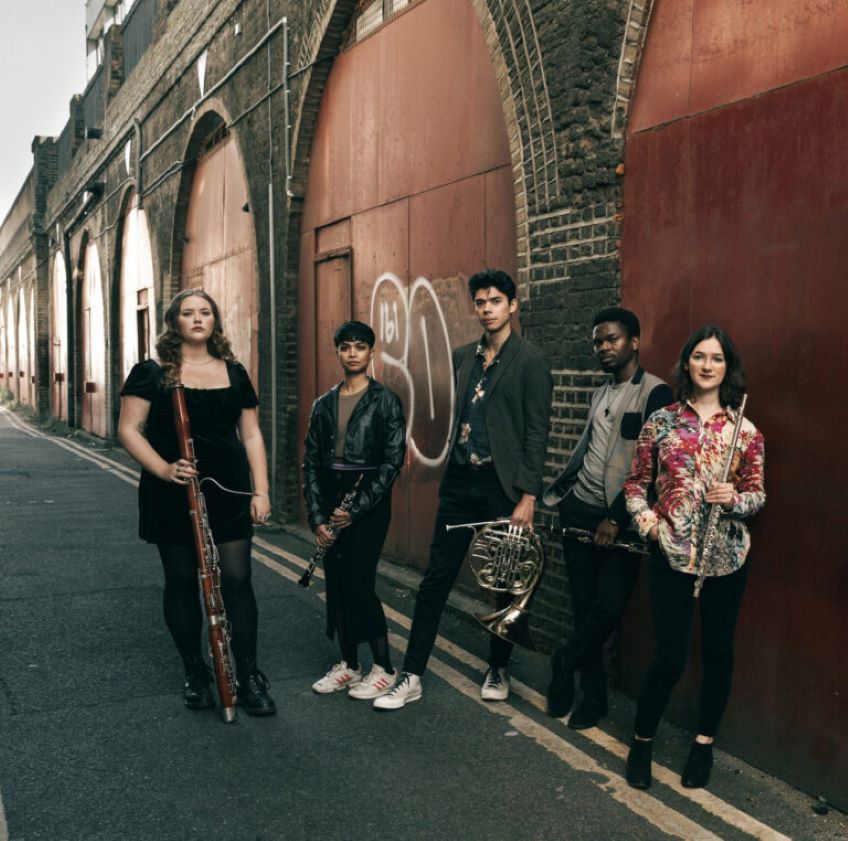Swaying freely with the music, the five talented wind-players of Bridge Ensemble, dressed in as-you-please casual, dance on their feet as they deliver an exciting programme, full of varieties of style, origin and technical challenge, and with an especially delightful second half.
Through Music in the Round’s “Bridging the Gap” scheme, which works to nurture, support and train emerging young talents, the Bridge was constructed two years ago. From diverse backgrounds themselves, the players are intent on basing stimulating music-making around diversity, inclusivity, virtuosity and fun while showcasing top-class chamber music, written by composers who have been hitherto unjustly neglected. Addressing the audience in a warm, informal manner in this intimate, in-the-round space, the players gave insights into themselves, the composers and pieces. Such friendly rapport, along with Daria Phillips’ bubbling bassoon, Meera Maharaj’s piping flute, Benjamin Garalnick’s resounding horn, the impressive, sparkling purity of Michael Stowe’s oboe-playing and Ola Akindipe’s virtuoso clarinet-playing, is ideal for their work in South Yorkshire schools, where they’re keen to inspire new generations of musicians from diverse backgrounds.
Each half began in resplendent style with a magnificent piece by Valerie Coleman, African-American composer and flautist, born in 1970. Umoja, Swahili for Unity, was originally written as a short choral piece, then arranged as quintet in 1997 for Coleman‘s Imani Winds (and later for orchestra). A rolling, bluesy feel with joyous, tuneful momentum fills the air as it does again in her fabulous, slightly longer Red Clay and Mississippi Delta, a massively exhilarating, virtuoso chamber work that “merges classical technique and orchestration with the blues dialect and charm of the south.” Clarinettist Ola Akindipe’s virtuoso playing thrills to infinity and beyond with Gerschwin-esque slides and masterly outbursts for he’s the loud-mouthed relative at a family gathering, he tells us, where instruments plus finger-clicks reflect all the chatter, spiky interjections, hold-ups, rushes, gushes and quieter, more relaxed moments of those assembled.
Florence Price (1887-1953) was another black woman composer and a prolific one. The first African American woman to have her symphony performed by a major orchestra (Chicago 1933) she was also an organist. Her glorious Adoration was originally written for organ, then adapted for violin and orchestra. In this quintet version, arranged by Peter Simcich, the players convey the broad serenity of its beautiful, lilting, hymn-like melody.
In the mix, too, are Danish, German, Mexican and Nigerian compositions. The works of Danish composer Otto Mortensen (1907-1986) were often based on folk songs and he brings pleasing varieties of lyrical, playful and wistful to his Quintette with fanfaring proclamations and tuneful combinations a-plenty also doing the rounds through the five instruments. Likewise ringing changes of tempi, textures and mood is Kammermusik for wind quintet, written in the 1920s by Paul Hindemith (1895-1963) with piping, playful jauntiness, insistent rhythms, catchy motifs, spiky stridencies, gentle dissonances and uneasy, yet pleasing, semi-tonal meanderings, reminiscent of Prokofiev and Stravinsky.
A different sumptuous treat, full of dancing, Mexican carnival flavour, mesmeric rhythms and sweeping tunefulness is Arturo Marquez’s wonderful Danza de Mediodia, much loved by horn-player Benjamin Garalnick, half Mexican himself, while the finale whisks us to Africa for Eko Scenes, composed by clarinettist Ola Akindipe. He keeps all five doubly busy as they tackle cahon, tom-tom played with hooked striker, sax and challenging hand-clapped rhythms as well as their regular instruments in a far-ranging, eclectic piece that reflects Ola’s childhood and songs his Nigerian mother sang. To ensure the audience finish the evening brimming with delight comes a joyous, ragtimey encore.
Audiences, it seems, can look forward to all manner of scintillating music from anywhere and everywhere as these players forge ahead, further honing the subtleties and blend in their playing together.
Eileen Caiger Gray




